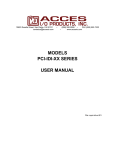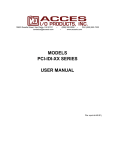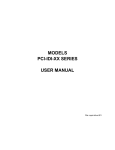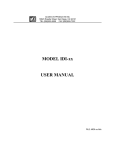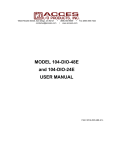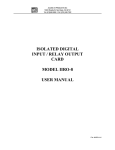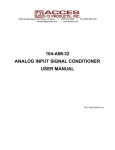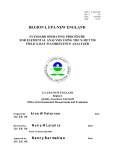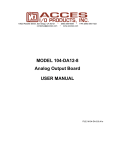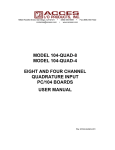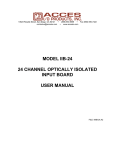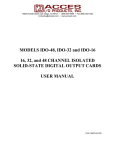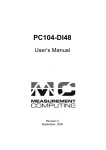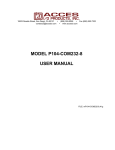Download MODEL 104-IDI-48 SERIES USER MANUAL
Transcript
10623 Roselle Street, San Diego, CA 92121 [email protected] • • (858) 550-9559 • FAX (858) 550-7322 www.accesio.com MODEL 104-IDI-48 SERIES USER MANUAL File: m104-idi-48.A1d Notice The information in this document is provided for reference only. ACCES does not assume any liability arising out of the application or use of the information or products described herein. This document may contain or reference information and products protected by copyrights or patents and does not convey any license under the patent rights of ACCES, nor the rights of others. IBM PC, PC/XT, and PC/AT are registered trademarks of the International Business Machines Corporation. Printed in USA. Copyright 2006 by ACCES I/O Products Inc, 10623 Roselle Street, San Diego, CA 92121. All rights reserved. WARNING!! ALWAYS CONNECT AND DISCONNECT YOUR FIELD CABLING WITH THE COMPUTER POWER OFF. ALWAYS TURN COMPUTER POWER OFF BEFORE INSTALLING A CARD. CONNECTING AND DISCONNECTING CABLES, OR INSTALLING CARDS INTO A SYSTEM WITH THE COMPUTER OR FIELD POWER ON MAY CAUSE DAMAGE TO THE I/O CARD AND WILL VOID ALL WARRANTIES, IMPLIED OR EXPRESSED. 2 Manual 104-IDI-48 SERIES Warranty Prior to shipment, ACCES equipment is thoroughly inspected and tested to applicable specifications. However, should equipment failure occur, ACCES assures its customers that prompt service and support will be available. All equipment originally manufactured by ACCES which is found to be defective will be repaired or replaced subject to the following considerations. Terms and Conditions If a unit is suspected of failure, contact ACCES' Customer Service department. Be prepared to give the unit model number, serial number, and a description of the failure symptom(s). We may suggest some simple tests to confirm the failure. We will assign a Return Material Authorization (RMA) number which must appear on the outer label of the return package. All units/components should be properly packed for handling and returned with freight prepaid to the ACCES designated Service Center, and will be returned to the customer's/user's site freight prepaid and invoiced. Coverage First Three Years: Returned unit/part will be repaired and/or replaced at ACCES option with no charge for labor or parts not excluded by warranty. Warranty commences with equipment shipment. Following Years: Throughout your equipment's lifetime, ACCES stands ready to provide on-site or in-plant service at reasonable rates similar to those of other manufacturers in the industry. Equipment Not Manufactured by ACCES Equipment provided but not manufactured by ACCES is warranted and will be repaired according to the terms and conditions of the respective equipment manufacturer's warranty. General Under this Warranty, liability of ACCES is limited to replacing, repairing or issuing credit (at ACCES discretion) for any products which are proved to be defective during the warranty period. In no case is ACCES liable for consequential or special damage arriving from use or misuse of our product. The customer is responsible for all charges caused by modifications or additions to ACCES equipment not approved in writing by ACCES or, if in ACCES opinion the equipment has been subjected to abnormal use. "Abnormal use" for purposes of this warranty is defined as any use to which the equipment is exposed other than that use specified or intended as evidenced by purchase or sales representation. Other than the above, no other warranty, expressed or implied, shall apply to any and all such equipment furnished or sold by ACCES. 3 Manual 104-IDI-48 SERIES Table of Contents Chapter 1: Introduction................................................................................................. 5 Table 1-1: Model Versions ....................................................................................... 5 Specification .............................................................................................................. 6 Figure 1-1: Block Diagram ...................................................................................... 7 Chapter 2: Installation................................................................................................... 8 Figure 2-1: PC/104 Key Information........................................................................ 9 Chapter 3: Option Selection ....................................................................................... 10 Figure 3-1: Option Selection Map.......................................................................... 11 Chapter 4: Address Selection .................................................................................... 12 Table 4-1: Standard Address Assignments for Standard Computers .................... 12 Table 4-2: Jumper Selection Example................................................................... 13 Chapter 5: Programming ............................................................................................ 14 Chapter 6: Connector Pin Assignments.................................................................... 16 4 Manual 104-IDI-48 SERIES Chapter 1: Introduction Features • • • • • Individually-Isolated AC/DC Inputs for two 24-bit groups, 48 total Reverse Polarity protection AC Filtering (first 24 channels) Optical Isolation, Channel-to-Channel and Channel-to-Host PC Change-of-State detection (certain models) Description This series of boards provides 48 optically-isolated inputs for AC/DC signals with Change-of-State (COS) Detection capability. Each input is reverse polarity protected and rectified by photo-coupler diodes. Standard 12/24 AC control transformer outputs can be accepted on the first 24 channels as well as DC voltages on all 48. The input range is up to 60VDC or AC RMS at frequencies of 40 to 10kHz. The first 24 input circuits contain a switchable filter that has a 4.7 millisecond time constant (without filtering, the response is less than 30 microseconds). The filter must be selected for AC inputs in order to eliminate the on/off response to AC. The filter is also valuable for use with slow DC input signals in a noisy environment. The filter may be switched out for DC inputs in order to obtain a faster response. Filters are individually selected by jumpers. See Figures 1-1 and 3-1 for jumper arrangements. The Change-of-State (COS) Detection capability (denoted by a “C” after the model number) provides a means to automatically interrupt the host computer in real time. When one or more input bits change state, a PCI interrupt is generated. That interrupt, in turn, can be used by your application program to initiate a poll of the inputs, then signal appropriate alarms, and/or initiate a scan of other I/O points that have not been previously activated. This can greatly simplify your application program and eliminate need to continuously poll inputs. Chapter 5 describes the programming aspects of the COS feature. These boards provide a much lower cost per point than externally-mounted, optically-isolated, solid-state modules or PLCs. Input connections are via 50-pin ribbon-cable headers on the card. These boards are especially useful in applications where high-common-mode external voltages are present as found in factory automation, energy management, security systems, and process monitoring applications. In addition to protecting your computer from accidental contact with high external voltages, the isolation provided eliminates troublesome ground loops. Letters are appended to the model numbers to signify options (described above) included on the card. Refer to Table 1-1 for model-specific information. MODEL No. of Bits Max Input Voltage 48A 48AC 48B 48BC 48 48 48 48 31V 31V 60V 60V Change-of State Interrupt Capability No Yes No Yes AC Filter Table 1-1: Model Versions 5 Manual 104-IDI-48 SERIES Yes Yes Yes Yes Specification Digital Isolated Inputs Number of inputs: 48 Type: Non-polarized, optically isolated from each other and from the computer (CMOS compatible) Voltage Range 48A: Logic Low: 0 to 1.5VDC or AC Rms (40 to 10kHz) Logic High: 3 to 31VDC or AC Rms (40 to 10kHz) 48B: Logic Low: 0 to 5VDC or AC Rms (40 to 10kHz) Logic High: 11 to 60VDC or AC Rms (40 to 10kHz) Isolation: Optically Isolated channel-to-ground or channel-to channel * see note Input Resistance 48A: 1.8K ohms in series with optocoupler 48B: 15K ohms in series with optocoupler Non-Filter Response Times: Rise Time = 10 uS / Fall Time = 30 uS Filter Time Constant: 4.7ms Power Required: +5VDC @ 300mA typical Environmental Operating Temperature: 0EC to 70EC (optional industrial temperature range -40EC to +85EC) Storage Temperature: -55EC to +150EC Humidity: 0% to 95% RH, without condensation Board Dimension: PC/104 format, 3.550” by 3.775” **Note on Isolation: Opto-Isolators and connectors are rated for at least 500V, but isolation voltage breakdowns will vary and is affected by factors like cabling, spacing of pins, spacing between traces on the PCB, humidity, dust and other environmental factors. This is a safety issue so a careful approach is required. For CE certification, isolation was specified at 60V DC or AC rms. The design intention was to eliminate the influence of common mode. Use proper wiring techniques to minimize voltage between channels and to ground. Tolerance of higher isolation voltage can be obtained on request by applying a conformal coating to the board. 6 Manual 104-IDI-48 SERIES Figure 1-1: Block Diagram 7 Manual 104-IDI-48 SERIES Chapter 2: Installation A printed Quick-Start Guide (QSG) is packed with the board for your convenience. If you’ve already performed the steps from the QSG, you may find this chapter to be redundant and may skip forward to begin developing your application. The software provided with this PC/104 Board is on CD and must be installed onto your hard disk prior to use. To do this, perform the following steps as appropriate for your operating system. Substitute the appropriate drive letter for your CD-ROM where you see d: in the examples below. CD Installation The following instructions assume the CD-ROM drive is drive “D”. Please substitute the appropriate drive letter for your system as necessary. DOS 1. Place the CD into your CD-ROM drive. 2. Type B- to change the active drive to the CD-ROM drive. 3. 4. Type GLQR?JJ- to run the install program. Follow the on-screen prompts to install the software for this board. WINDOWS 1. Place the CD into your CD-ROM drive. 2. The system should automatically run the install program. If the install program does not run promptly, click START | RUN and type BGLQR?JJ, click OK or press -. 3. Follow the on-screen prompts to install the software for this board. LINUX 1. Please refer to linux.htm on the CD-ROM for information on installing under linux. 8 Manual 104-IDI-48 SERIES Installing the Hardware Before installing the board, carefully read Chapter 3 and Chapter 4 of this manual and configure the board according to your requirements. The SETUP Program can be used to assist in configuring jumpers on the board. Be especially careful with Address Selection. If the addresses of two installed functions overlap, you will experience unpredictable computer behavior. To help avoid this problem, refer to the FINDBASE.EXE program installed from the CD. The setup program does not set the options on the board, these must be set by jumpers. To Install the Board Install jumpers for selected options and base address according to your application requirements, 1. as mentioned above. 2. Remove power from the PC/104 stack. 3. Assemble standoff hardware for stacking and securing the boards. 4. Carefully plug the board onto the PC/104 connector on the CPU or onto the stack, ensuring proper alignment of the pins before completely seating the connectors together. 5. Install I/O cables onto the board’s I/O connectors and proceed to secure the stack together or repeat steps 3-5 until all boards are installed using the selected mounting hardware. 6. Check that all connections in your PC/104 stack are correct and secure then power up the system. 7. Run one of the provided sample programs appropriate for your operating system that was installed from the CD to test and validate your installation. Figure 2-1: PC/104 Key Information 9 Manual 104-IDI-48 SERIES Chapter 3: Option Selection FILTER RESPONSE SWITCH Filters are used to select input filtering on a channel-by-channel basis. When jumper FLT 0 is installed, filtering is introduced for input BIT 0, FLT 1 for BIT 1, etc. JUMPER SELECTION Bit Filtered JUMPER SELECTION FLT-0 FLT-1 FLT-2 ... Bit 0 Bit 1 Bit 2 ... … FLT-21 FLT-22 FLT-23 Bit Filtered … Bit 21 Bit 22 Bit 23 This filtering provides a slower response for DC signals as described previously and must be used when AC inputs are applied. If you believe an input may be electrically noisy, install the jumper to avoid false readings. INTERRUPTS Select the desired interrupt level by installing a jumper at one of the locations marked IRQxx. If IRQs are enabled in software, an interrupt latch is set by the board when an Isolated Digital Input bit changes state. A full description of how to enable/disable and clear IRQs is described in the Programming section of this manual. Refer to Figure 3-1 for more on filter and interrupt selection. 10 Manual 104-IDI-48 SERIES P2 FILTER SELECT JUMPERS P1 ADDRESS 0x300 Figure 3-1: Option Selection Map 11 Manual 104-IDI-48 SERIES Chapter 4: Address Selection The board occupies 8 consecutive addresses in I/O space. The base or starting address can be selected anywhere within ght I/O address range of 100-3FF, provided that it does not cause an overlap with other functions. If the addresses of two installed functions overlap, you will experience unpredictable computer behavior. The FINDBASE program supplied with the product will assist you in selecting a base address that will avoid this conflict. HexRange Usage 000-00F 020-021 040-043 060-06F 070-07F 080-09F 0A0-0BF 0C0-0DF 0F0-0F1 0F8-0FF 170-177 1F0-1F8 200-207 238-23B 23C-23F 278-27F 2B0-2BF 2C0-2CF 2D0-2DF 2E0-2E7 2E8-2EF 2F8-2FF 300-30F 310-31F 320-32F 370-377 378-37F 380-38F 3A0-3AF 3B0-3BB 3BC-3BF 3C0-3CF 3D0-3DF 3E8-3EF 3F0-3F7 3F8-3FF DMA Controller 1 INT Controller 1, Master Programmable Interrupt Timer Keyboard Controller Real Time Clock, NMI Mask DMA Page Register INT Controller 2 DMA Controller 2 Math Coprocessor Math Coprocessor Fixed Disk #1 Fixed Disk #2 Game I/O Bus Mouse Alt. Bus Mouse Parallel Printer EGA EGA EGA GPIB (AT) Serial Port Serial Port Prototype Board Prototype Board Hard Disk (XT) Floppy Controller #2 Parallel Printer Port 1 SDLC SDLC Monochrome Display/Printer Parallel Printer Port 2 VGA EGA CGA Serial Port Floppy Diskette Controller Serial Port Table 4-1: Standard Address Assignments for Standard Computers The board’s base address is set up by JUMPERS (see Figure 3-1). Those jumpers control address bits A3 thought A9. (Lines A2, A1 and A0 are used on the board to select the offset from the jumper-selected base address. This is referred to as the Base + ‘offset’ in the programming section.) To determine how to set these jumpers for a desired hex-code address, refer to the SETUP program provided with the board. If you prefer to determine proper jumper settings yourself, first convert the hex-code address to binary form. Then, for each “0”, install corresponding jumpers and for each “1” remove the corresponding jumper. 12 Manual 104-IDI-48 SERIES The following example illustrates jumper selection corresponding to hex 300 (or binary 11 0000 0xxx). The “xxx” represents address lines A2, A1, and A0. Base Address in Hex Code Conversion Factors Binary Representation Jumper Legend Address Line Controlled Jumper Selection 3 2 1 A9 A9 OFF 0 1 1 A8 A8 OFF 8 0 A7 A7 ON 4 0 A6 A6 ON 2 0 A5 A5 ON 1 0 A4 A4 ON 0 8 0 A3 A3 ON Table 4-2: Jumper Selection Example 13 Manual 104-IDI-48 SERIES Chapter 5: Programming The board occupies eight consecutive addresses in PC I/O space. The base address is during installation and will fall on an eight byte boundary. The card’s read and write functions are as follows: Address Read Write Base Address + 0 Port 0 Low Byte N/A Base Address + 1 Port 0 Mid Byte N/A Base Address + 2 Port 0 High Byte N/A Base Address + 3 N/A N/A Base Address + 4 Port 1 Low Byte N/A Base Address + 5 Port 1 Mid Byte N/A Base Address + 6 Port 1 High Byte N/A Base Address + 7 IRQ Status Register/IRQ Clear IRQ Enable/Disable Note: Base + 7 only applies to COS (“C”) boards Read Base + 0 (+1, +2, +4, +5, +6) Bit 7 Bit 6 Bit 5 Bit 4 Bit 3 Bit 2 Bit 1 Bit 0 D7 of input data D6 of input data D5 of input data D4 of input data D3 of input data D2 of input data D1 of input data D0 of input data Reading a byte from the Port Data Base Address reads the 8 bits associated with that third of a port. The Addresses labeled “Low Byte” are associated with pins 3 through 18, the Addresses labeled “Mid Byte” are associated with pins 19 through 34, and the Addresses labeled “High Byte” are associated with pins 35 through 50, as shown in Chapter 6, connector pin assignments. Writing to these addresses has no effect. Address Base + 7 is used to control and monitor Change-of-State IRQs. COS IRQs are enabled/disabled on 8 bit boundaries (Port’s Low, Middle, and/or High byte). To enable COS IRQs, write a “1” to the bit corresponding to the Port’s Low, Middle and/or High byte. The “Write Base + 7” table describes which bits enable each byte. Writing “0” to the bit will disable COS IRQs for that byte. A read from bit 7 will show a “1” if one or more of the COS IRQs have been enabled. Once COS IRQs have been enabled for the byte(s), a change of input level (low-to-high or high-to-low) within that byte(s) will set the IRQ latch. After an IRQ is generated, bit 6 of Base + 7 will be set Low (“0”), which can be used to confirm that a shared interrupt was generated by this board. Also, bits 0-5 will be set High (“1”) depending upon which byte(s) the COS occurred on. Any read of Base + 7 will clear the IRQ latch, return bit 6 to it’s High (“1”) state, and return bits 0-5 to their Low (“0”) state. For more on reading Base + 7 refer to the “Read Base + 7” table. Please note: Enabling or Disabling IRQs does not clear the IRQ latch. If you disable IRQs while one is pending, it is still required to read from Base + 7 to clear the pending IRQ. 14 Manual 104-IDI-48 SERIES Read Base + 7: COS Status Register Bit 7 Bit 6 Bit 5 Bit 4 Bit 3 Bit 2 Bit 1 Bit 0 IRQ Enable Status IRQ Status (Active Low) Port 1 High Byte IRQ Status Port 1 Mid Byte IRQ Status Port 1 Low Byte IRQ Status Port 0 High Byte IRQ Status Port 0 Mid Byte IRQ Status Port 0 Low Byte IRQ Status Write Base + 7: COS Enable/Disable Register Bit 7 Bit 6 Bit 5 Bit 4 Bit 3 Bit 2 Bit 1 Bit 0 N/A N/A Port 1 High Byte IRQ Enable / Disable Port 1 Mid Byte IRQ Enable / Disable Port 1 Low Byte IRQ Enable / Disable Port 0 High Byte IRQ Enable / Disable Port 0 Mid Byte IRQ Enable / Disable Port 0 Low Byte IRQ Enable / Disable 15 Manual 104-IDI-48 SERIES Chapter 6: Connector Pin Assignments Two identical 50-pin right-angle headers are provided on the product, one for each 24-bit input group. Port 0 is located on the same side as the address jumpers, while Port 1 is on the opposite side, near the IRQ level jumpers. Connector pin assignments are listed below for Port 0. Port 1 follows the same pinout but for bits 24-47. PIN NAME PIN NAME 1 GND 2 NC 3 Bit 0 A 4 Bit 0 B 5 Bit 1 A 6 Bit 1 B 7 Bit 2 A 8 Bit 2 B 9 Bit 3 A 10 Bit 3 B 11 Bit 4 A 12 Bit 4 B 13 Bit 5 A 14 Bit 5 B 15 Bit 6 A 16 Bit 6 B 17 Bit 7 A 18 Bit 7 B 19 Bit 8 A 20 Bit 8 B 21 Bit 9 A 22 Bit 9 B 23 Bit 10 A 24 Bit 10 B 25 Bit 11 A 26 Bit 11 B 27 Bit 12 A 28 Bit 12 B 29 Bit 13 A 30 Bit 13 B 31 Bit 14 A 32 Bit 14 B 33 Bit 15 A 34 Bit 15 B 35 Bit 16 A 36 Bit 16 B 37 Bit 17 A 38 Bit 17 B 39 Bit 18 A 40 Bit 18 B 41 Bit 19 A 42 Bit 19 B 43 Bit 20 A 44 Bit 20 B 45 Bit 21 A 46 Bit 21 B 47 Bit 22 A 48 Bit 22 B 49 Bit 23 A 50 Bit 23 B 16 Manual 104-IDI-48 SERIES Customer Comments If you experience any problems with this manual or just want to give us some feedback, please email us at: [email protected]. Please detail any errors you find and include your mailing address so that we can send you any manual updates. 10623 Roselle Street, San Diego CA 92121 Tel. (858)550-9559 FAX (858)550-7322 www.accesio.com 17 Manual 104-IDI-48 SERIES

















